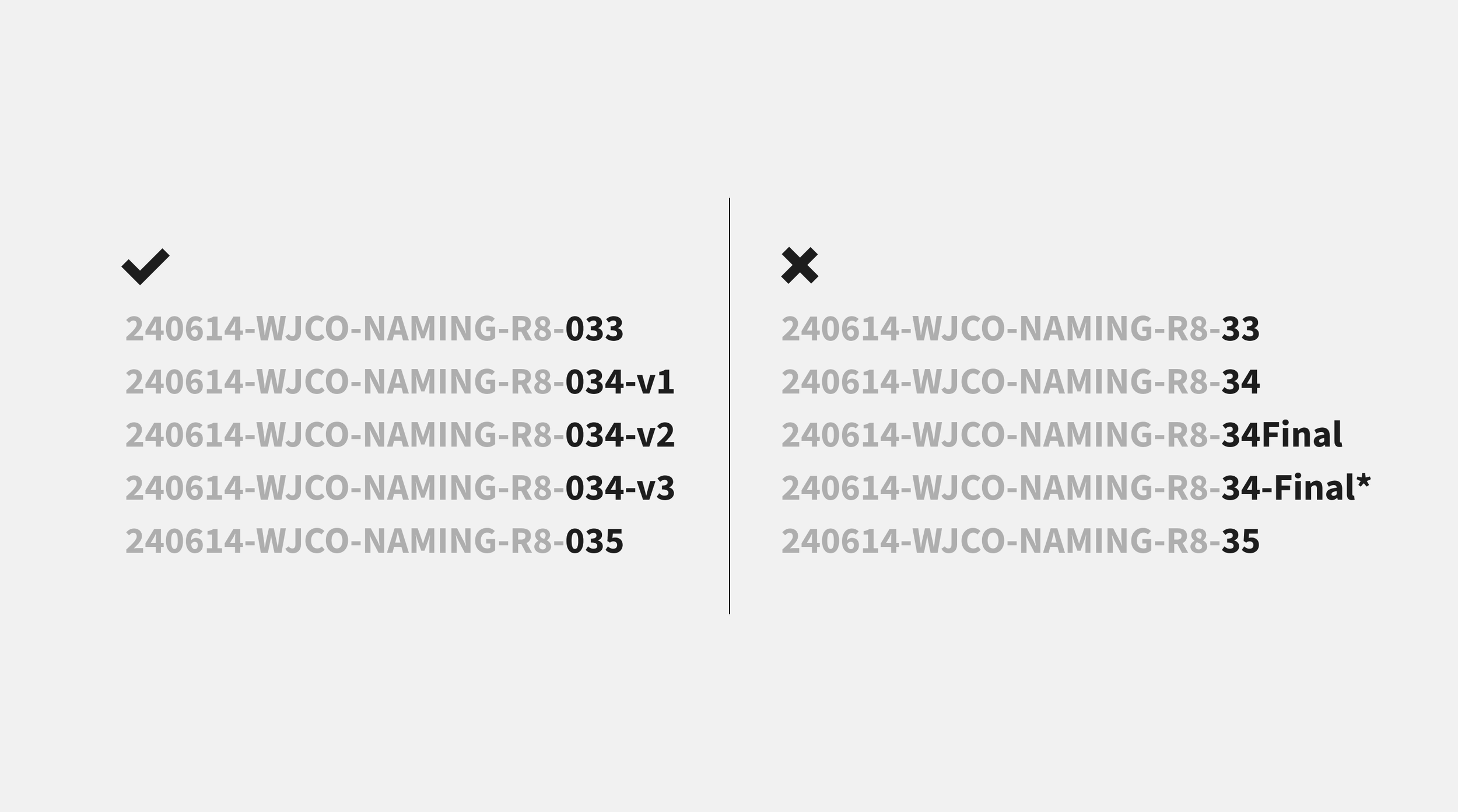The ideal way to name your files.
How to name files was one of the first things I learned when I started my first job at an advertising agency.
And as simple as it seems, it's one of the most critical project management skills one can have. Correctly named files are the difference between losing assets and your mind and being able to find things with your eyes closed. Files are the atomic elements of a rock-solid data management system, and how they're named creates the organization for your organization.
My strategy is to name files so that someone who comes across one for the first time will have a general idea of what it is just by reading the name.
Like I said, it's not hard, but it takes diligence. Here's how.
Oh, and while this is mostly for photo and video assets, the naming convention applies to pretty much anything.
Hyphens only, no spaces, underscores, or special characters.
First, you only want to use hyphens to separate anything in your file name.
You shouldn't use underscores, and you definitely don't want to use spaces. This is because search engines will interpret a hyphen as a space between words while an underscore is read as a joiner. And, while you could use spaces, not all applications support spaces in file names, and it can cause errors if you try to load one in.
Also, don't use any special characters like " / \ [ ] : ; | = , < ? > & $ # ! ‘ { } () *. Those cause errors, too. Letters and numbers only.
Descending dates, first.
The key to this naming convention is all about how you type out the dates.
By starting with the Year > Month > Day, you inherently build in automatic sorting, as all files will order themselves by date.
And, while you could type out the whole year, like 2024, I like to keep it to just two characters to save space. Then, I'll also add zeroes to single-digit numbers to keep all dates the same width. So, June 14, 2024, becomes 240614.
By doing this, you'll be able to quickly navigate to any asset by simply knowing the date.
Brand code.
Following the date, I include a two to four-character code to identify the brand or project I'm working with.
Sometimes, this can be the full brand name like BMW or YETI. Or, it's an abbreviation like TNF for The North Face. Whatever makes sense to you and whoever you may be working with.
Project code.
Now, the Brand Code isn't enough to distinguish one project from another with the same brand, so you'll also need to come up with a shorthand for the specific project you're working on.
Naturally, this will be a bit more descriptive, but you also want to keep it relatively short. You want your file names to be at most 25 characters. The shorter, the better.
If you're at a specific location, you could use that, or if it's a studio shoot, you could use "studio." Or, if it's a fall campaign, you could use "fall-campaign."
Part of coming up with the Project Code is knowing everything in the file name provides context, so you don't need to rely solely on any one aspect of it.
Hardware code.
A Hardware Code isn't always necessary, but if you have a project where you're creating multiple assets at the same time and want to know where they came from, you should add this in before the Asset Numbering.
Specifically, I'm thinking of a photo or video shoot with multiple cameras or when you're capturing video and audio.
If that's the case, you'll want to quickly be able to identify which assets came from what camera or device.
For example, if you're on a shoot with two Canon R5 cameras and are capturing audio with a Zoom F3, you could add R51 to the first camera's files and R52 to the others, with F3 added to the audio files.
Asset numbering.
When importing your assets, you want to add them in the order they were captured starting from 1.
You'll also want to pad all numbers with additional zeros so they take up the same amount of space. This means if you have less than 1,000 but more than 100 assets, you would have three number spaces and start at 001. This makes sure each number takes up the same amount of space and is easier to read.
Then, the one thing I am conscious of when exporting some but not all of the assets is to make sure the Asset Number stays the same. You don't want asset 035 to become asset 004 after a partial export. It'll just be a mess trying to reconcile everything.
Version code.
Another "only-as-needed" aspect of this naming convention is adding Version Codes. Add these after the Asset Number so you don't break the rest of the system and can keep track of each new asset. To create these, I'll start by adding v1 and then increasing the number v2, v3, etc, with each new file.
Consistency.
All systems are only as good as the people who use them. The key is being consistent. It only works if everyone is committed to it.
That's it, a simple, straightforward naming convention for your digital assets. The key is consistency, as this only works if everyone is committed to it. But how you name your files is only one part of it. You also need a systematic folder structure to keep them in and a backup strategy to keep them safe.




